Two major bike launches will see 2012 go down as a landmark year for Trek. After the launch of the Domane in April, the American firm unveiled the overhauled Madone in June.
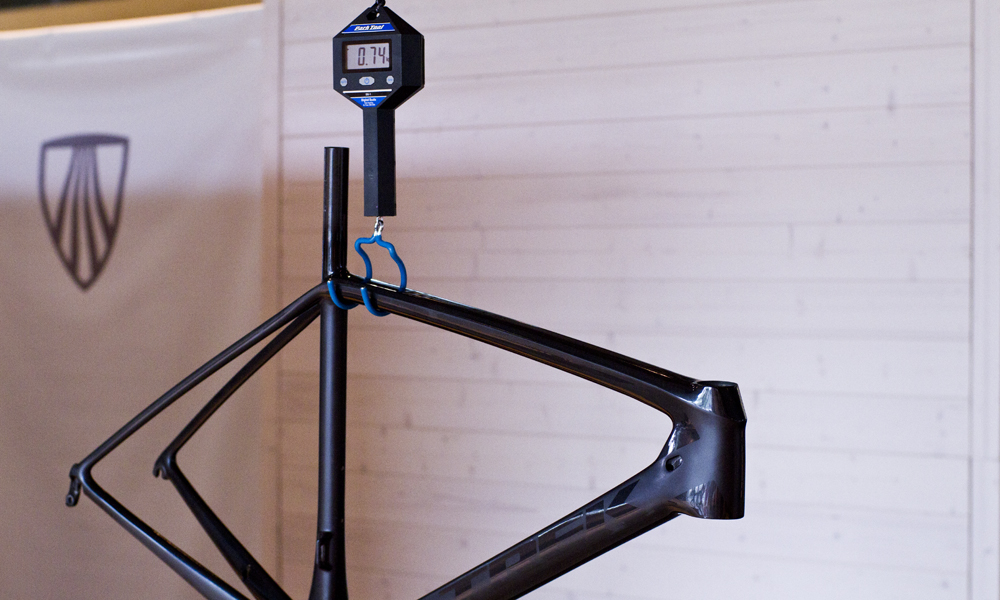
Both launches came before major races – the Tour of Flanders and Tour de France respectively – which delivered a hint to each machine’s raison d’être.
The Domane, developed in conjunction with Fabian Cancellara, is Trek’s ‘endurance’ machine thanks to its innovative IsoSpeed decoupler, which essentially isolates the seattube from the toptube to improve comfort, while the new Madone is the Wisconsin-based company’s aero and super-light racing thoroughbred.
Trek’s road bike product manager Ben Coates, who previously worked closely with Lance Armstrong as Trek’s pro team liaison manager, has overseen both projects and talked RoadCyclingUK through their development.
Trek’s development cycle typically starts on their high-end machines, with a professional cyclist or a team. The Madone, launched in its first iteration in 2003, has had a complete redesign.
“With the Madone we got ourselves into a bit of a pickle,” said Coates. “We didn’t have a problem [with the existing Madone]. Our athletes loved our bike, and our retailers loved our bike – but after a long in-house conversation we identified aerodynamics and weighs as two areas in which we could improve.”
Trek had aerodynamics covered in part thanks to the KVF – Kammtail Virtual Foil – tube shape developed for the Speed Concept time trial bike.
“We could have taken the easy way out and strapped a handlebar to the Speed Concept and called it a day but it’s not exactly the right application for the technology,” said Coates. “You’d increase the weight and the rigidity would change significantly.”
But, after many hours in the wind tunnel, Trek’s engineers found an application suitable for a road bike and applied that tube shape, essentially a truncated aerofoil with the rear chopped off thereby tricking the wind into believing the tail is still there but without the weight penalty, to as many areas of the frame as possible: to the fork, downtube, seattube and seatstays. The next step was to ensure the brakes were included in that shape.
“Brakes are traditionally bulbous and slow; slowing you down even when you don’t use them,” said Coates.
“Tucking the front brake into the fork, making it part of the leading edge, actually lengthened the airflow shape and made a beautifully integrated, fast solution, while pulling the rear brake from the seatstays and placing it behind the bottom bracket gave us a pretty big gain.”
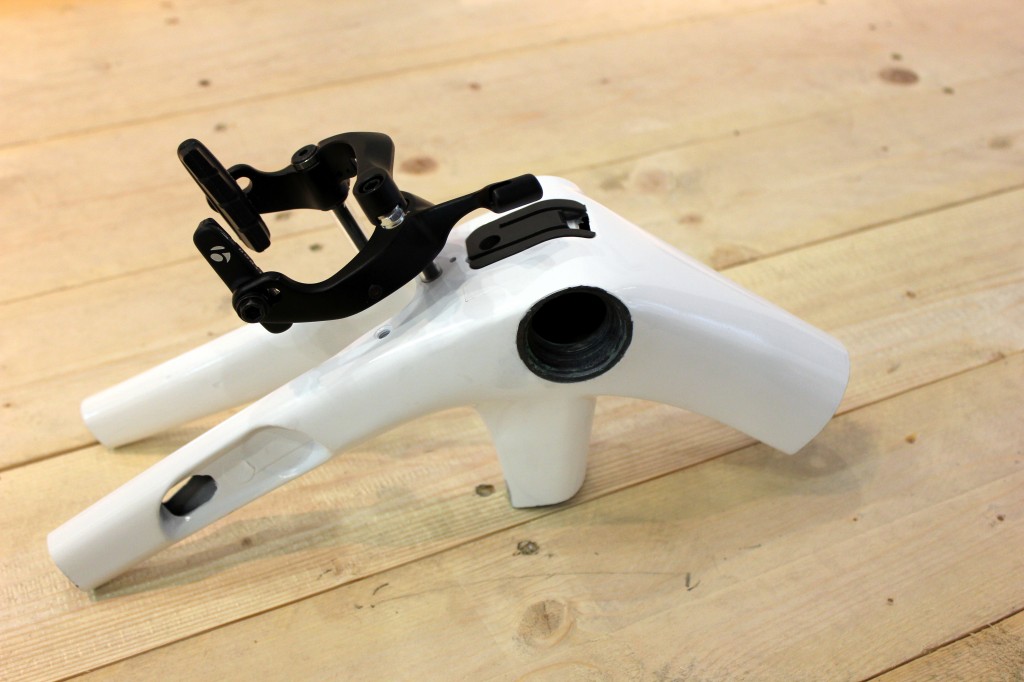
An aerodynamic frame typically weighs more than 1,000g but the top-of-the-range Madone 7-Series now weighs just 750g, which is 18 per cent lighter than the previous Madone at 915g. By integrating the brakes, Trek had also taken the first steps in reducing the weight of the frame.
“All brakes historically have had a gate – the piece which connects the two pivots to a simple attachment point so you can bolt it onto the frame,” said Coates. “We said ‘what do we need that for’ and tossed it out and bolted the pivots directly to the bike. That meant we could also take material out of the frame.
“By taking the brake off the seatstays, we threw out the brake bridge, which had no function other than to put a brake on, and we took out all the supporting carbon fibre around the seatstays which had to support the brake bridge to allow it to do its job.
“We bolted the brake to the bottom bracket, which already has a bunch of material there because it has to be stiff, and used that material to serve two functions, thereby reducing the overall weight of the bike.
“At the front of the bike, now we don’t have to have a hole which pierces both sides of the fork crown. The crown’s robust because it has to be safe to steer the bike properly. If you put a hole through it then you have to reinforce the entire hole. Now there’s only nutserts which are moulded in through the back side so we actually have more continuous fibre while being able to reduce weight.”
The overhauled Madone is available in 7, 6 and 5-Series versions, with each using a different grade of carbon fibre. Trek’s 700 Series OCLV carbon fibre, used on the 7-Series Madone, is their lightest and stiffest to date.
“Our partners have developed new carbon fibres – defence grade carbon fibres – which you can’t actually access outside of the US, so it’s really proprietary stuff which is very expensive,” said Coates. “OCLV allows us to use those carbon fibre in exactly the right areas to make sure we increase the stiffness and reduce the weight.”
In an effort to offer riders the lightest frame possible, Trek offer their new U5 Vapour Coat paint scheme as an optional extra. A top-of-the-range paint job typically weighs around 40g but Trek claim the U5 Vapour Coat weighs less than 5g.
It’s the ultimate marginal gain and Coates believes Trek have covered every base in creating a racing machine which is both aerodynamic and super-light like no other, without sacrificing ride quality.
“We promised ourselves that this will be a Madone,” said Coates, who revealed more than 300 iterations of the new Madone were tested by Trek’s employees and sponsored riders.
“This is among the stiffest bikes out there but it’s not the stiffest bike. We actually decided not to make the stiffest bike because of ride quality but, in terms of compliance, the Madone is the most compliant bike on the market aside from the Domane.
“Package that all up and the new Madone 7-Series, as a fuselage, is on a par with the lightest bikes out there, and on a par with the most aerodynamic bikes out there,” he said. “Our rivals in one category are normally giving up on a big scale in the other.”
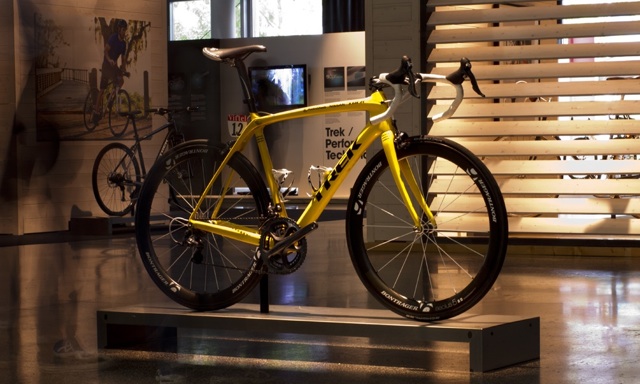
While the Madone has significant heritage as a racing machine, the Domane was a ground-up design which started from a conversation with Radioshack-Nissan-Trek rider Fabian Cancellara.
“We’ve never had a rider like Fabian,” said Coates. “He’s so discerning with his equipment.
“The Domane started with an easy statement from Fabian: less in, more out. That’s what he kept saying to me in terms of what he wants.
“We boiled that down over a few months. He wants comfort, efficiency and stability, which is great because everyone who rides a bike understands what they are. We can all relate to that.”
With Cancellara’s demands at the heart of Trek’s design philosophy, the Domane was developed to help the Swiss rider, winner of the Tour of Flanders and Paris-Roubaix double in 2010, win more cobbled Classics.
“We tested with accelerometers and with strain gauge bikes, we moulded cobbles and laid down a map of the Arenberg Forest course,” said Coates. “We really began to understand what happens to a bike on rough roads and on smooth roads.
“We developed a ton of ideas and pushed them out to our test riders, before narrowing them down to one solution for each of those areas that Fabian was looking for.”
For comfort Trek developed the IsoSpeed decoupler and fork, and IsoZone handlebar; efficiency came by way of the Domane’s PowerTransfer construction; and a re-tuned geometry delivered in the stability stakes.
“The reason we call it a decoupler is that it removes the seattube connection from the toptube,” explained Coates. “We’re now able to tune the seattube to have massive compliance – it’s 50 per cent more compliant than the previous Madone.
“At the front we have the IsoSpeed fork has a similar effect but it’s done strictly with geometry. By sweeping the fork legs out in front and reversing the dropouts, we’re able to increase the compliance by five per cent – which is a pretty massive number for a fork – and increase stiffness by 30 per cent, so there’s more rigidity to improve the handling characteristics.
“And the IsoZone handlebar has integrated pads which reduce vibration displacement by 20 per cent.”
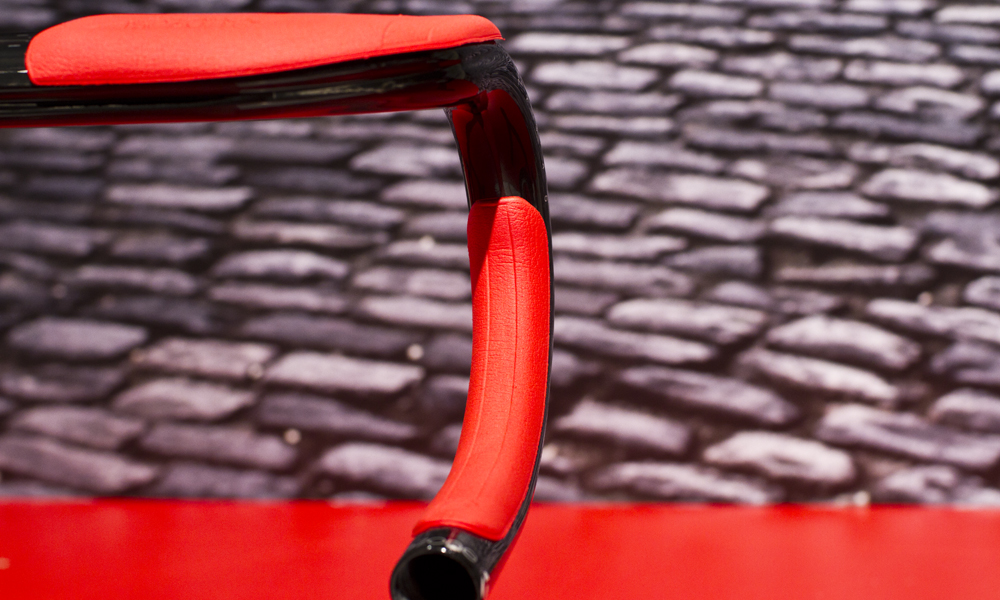
The Domane’s PowerTransfer construction is based around Trek’s asymmetric E2 headtube and BB90 bottom bracket, the widest available on a road bike, which are linked by a super-wide downtube designed to transfer more power.
As for stability, Coates says the Domane’s ‘endurance fit’ is the world’s most comfortable racing geometry.
“We lengthened the wheelbase to increase stability, lowered the bottom bracket to improve your connection with the bike, increased the headtube length, decreased the headtube angle and increased the fork rake,” said Coates.
“In a straight line the Domane is super-stable when you take your hands off the ‘bars, but when you start to put input into it then it has the feel of a Trek race bike.”
The Domane’s technology has quickly trickled down the range, with 6-Series, 5-Series and 4-Series versions of the frame available, based around a carbon fibre frame, while Trek soon followed up with two 2-Series aluminium models.
“We can manufacture a $12,000 dollar bike and put it on a pedestal but it doesn’t really help a lot of people,” said Coates. “It doesn’t help retailers grow their business, and it doesn’t really help consumers build their excitement of cycling because they can’t ride it. We wanted to make sure the offering spans every price point.”
Using aluminium, rather than carbon fibre, to build the frame presented Trek with a whole new problem – aluminium fatigues over time. In order to achieve the required compliance while maintaining strength, Trek welded two tubes together to form the seattube.
“The IsoSpeed decoupler functions in very much the same way but it was a very complicated frame for us to make,” said Coates. “We actually had to end up welding two tubes together which have two different set of characteristics to control the amount of dampening and compliance.
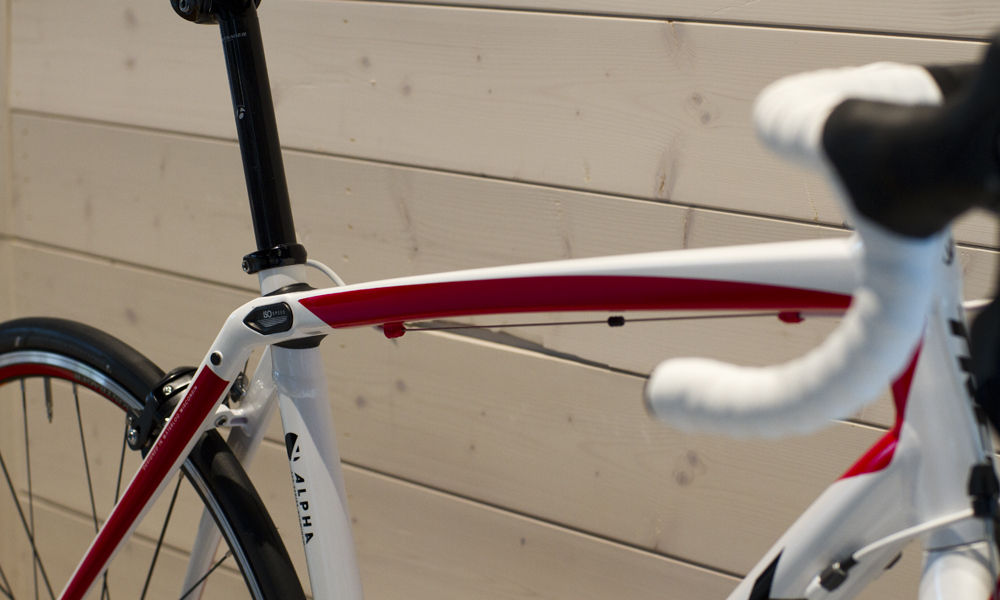
Coates admits some may question the longevity of the Domane’s seattube weld due to the fatigue properties of aluminium but he is confident in the frame’s robustness, with Trek offering a lifetime warranty as a result.
“The aluminium has been tested to extreme fatigue cycles,” said Coates. “The weld is integral to the success of the bike. We tried other ways to make the compliance function properly but actually joining two completely different tubes was the most successful so it works very well and that’s part of the technology. It requires that joint to control the flexibility.”
The aluminium Domane 2.0 and 2.3 models are expected to arrive in November – just in time for winter – and Coates expects their suitability as a year-round bike to be popular with UK riders.
“I think there’s a high demand for an aluminium bike which can be well equipped with big tyres and mudguards, which works well as a primary bike or a well thought-out winter bike on bad roads,” he said.
Coates is also keen to point out the Domane’s suitability, particularly in its carbon fibre guise, as a race bike, and Cancellara made the top-of-the-range Domane his bike of choice through the entire season.
What, then, separates the Madone and the Domane? “When you ride them you can feel they’re completely different,” said Coates.
“If you know where you’re going and you just want to get there faster, you’ll want to be on a Madone, but if you just want to ride for longer, you’ll probably want to be on a Domane. It’s a lifestyle choice.”





